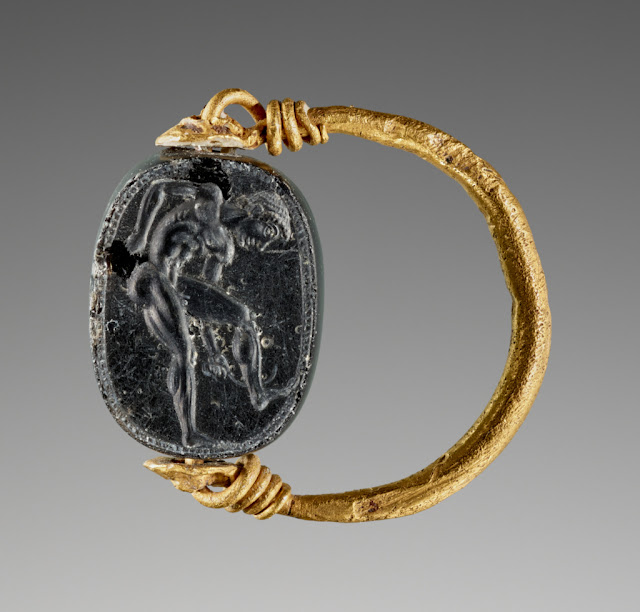Roman athletics (as opposed to spectator sports)
Depictions of athletes were popular on gems of the late 500s BCE and thereafter. Not only Greek but Etruscan artisans produced these miniature works of art and the collection of these gems became popular among the Roman elite. As I've mentioned previously, both Julius Caesar and Pompey the Great collected them.
One such artist, Epimenes, from the Cyclades, produced scenes of nude youths with meticulously defined musculature in complex twisted poses. His youths sported locks of hair radiating from the crown of the head with clusters of curls on the forehead. He adopted these features from innovations in sculpture and vase-painting at the time.
"It is clear that some form of amateur athletics must have taken place simultaneously with the real business at hand, which was, naturally enough from the bias of Republican Rome, training for war," observes classicist Donald White, University of Pennsylvania Museum of Archaeology and Anthropology. "Special ludi including sports that may be assumed to have stressed physical endurance, team work, and courage were part of the routine conduct of the Juventus, an ancient Italic institution for the training of young males eventually revived by Augustus."
White points out that even Marcus Cato the Censor (234-149 BCE), who constantly reminded Rome's senate that Carthage must be destroyed, took pains to instruct how own son in “his grammer, law, and his gymnastic exercises. Nor did he only show him, too, how to throw a dart, to fight in armor, and to ride, but to box also and to endure both heat and cold, and to swim over the most rapid and rough rivers” (Plut. Vit. Cat. Mai., Clough trans., p. 251). The Campus Martius served Roman youth as an exercize ground. Cato also scorned overweight men saying ‘What use can the state turn a man’s body to, when all between the throat and groin is taken up by the belly?”
Boxing (pugilatio) was imported from Greece and Livy (i, 35) records that Tarquinius Priscus imported boxers from outlying areas for his inaugural celebration as early as the 6th century BCE including Etruria where pugilism flourished. One famous Roman-era boxer, Melankomas, from Caria and victor in the 207th Olympiad in 49 CE supposedly gained fame because he avoided the punches of other boxers and never threw any punches himself. Dio says he never lost a match, hit an opponent, or was struck by an opponent. (I wonder how he managed that while maintaining the goodwill of the crowd?)
Foot races and even races on mule-back were also conducted and scholars suggest there were at least some amateur participation. The festival of the Robigalia on April 25, featured foot races in honor of Robigus, the god who averted mildew, and the Consualia on August 21, with its races on foot and on mule-back were conducted in honor of the ancient Italic deity Consus, who presided over secret plans and counsels.
"A number of prominent Republican figures attempted to introduce Greek style athletic games to Rome, says White. "The earliest of these were staged in 186 BCE by Marcus Fulvius Nobilior, who imported large numbers of Greeks to perform in Rome. A century later the dictator Lucius Cornelius Sulla managed to clean out nearly all of Greece to provide athletes to help celebrate in Horne his victory over Mithridates, which meant that in 81 BCE the best that Olympia could put on for its games was the foot race. Similar efforts were repeated by Pompey, Julius Caesar and Augustus."
Both Caligula and Claudius staged gymnastic competitions for the Roman people but participation was limited to foreign athletes. Nero, however, encouraged Roman aristocrats to compete with the lower classes in a variety of athletic events at his "Youth Games" in 59 CE. He constructed a Greek style gymnasium complex in 62 CE in the vicinity of the Pantheon to facilitate athletic training, that was the first such structure to he erected in Rome.
White points out, though, that the more conservative element in Roman society disapproved of the resulting activity. Tacitus remarks “Birth age, official career did not prevent people from acting in Greek or Latin style—or from accompanying their performances with effeminate gestures and songs. Eminent women, too rehearsed indecent parts. . . Places of assignation and taverns were built, and every stimulus to vice was displayed for sale. . . Promiscuity and degradation throve. Roman morals had long become impure, hut never was there so favorable an environment for debauchery as among this filthy crowd” (Ann. pp. 310-11, M. Grant trans.).
"Perhaps the insinuations of sexual misconduct arose in large measure from merely the sight of athletes competing naked in front of both sexes, but we do hear of one Palfitrius Sura, son of a consul, wrestling naked with a girl from Sparta," White says.
Donald White's article goes on to discuss wrestling (both male and female) and the often bloody pankration (A 3rd century CE Roman army recruit named Lucius Septimius Flavianus Favillianus gained fame as a champion wrestler and pankrationist) as well as palestra games using balls such as harpastum (a game featured in Anthony Riches, "Betrayal", Book 1 of his Centurions trilogy), pila pagancia, and trigon. His article includes images of mosaics depicting various athletic competitors that I found really interesting as well.
You can read it here:
https://www.penn.museum/sites/expedition/roman-athletics/





Comments
Post a Comment